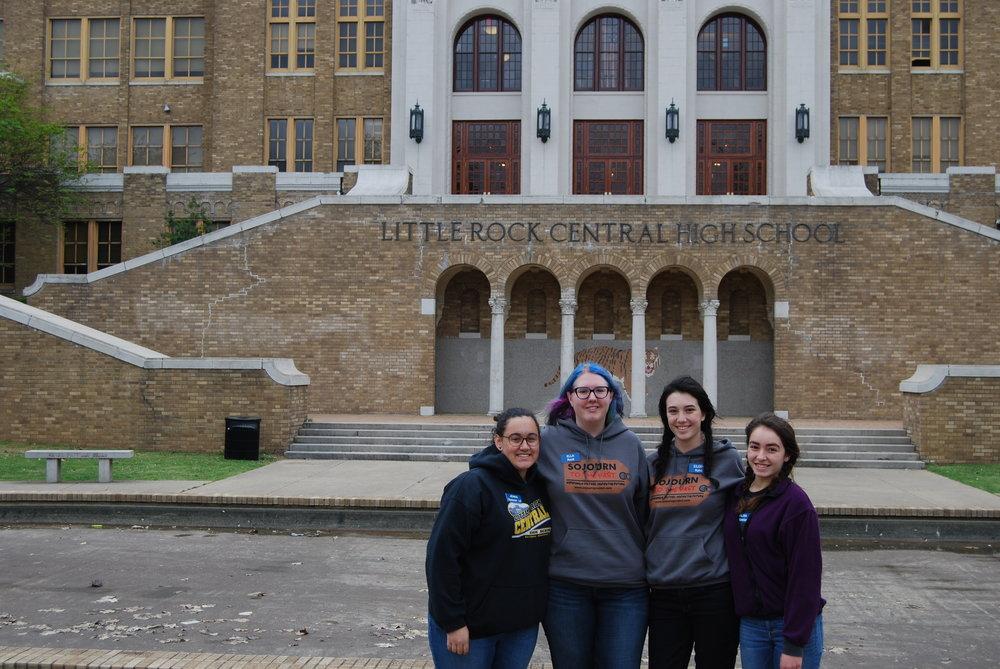Sojourn to the past- students experience history
May 5, 2017
 Junior Eileen Kohli poses with friends in front of Little Rock Central High School, which became a symbol of desegregation during the Civil Rights Movement.
Junior Eileen Kohli poses with friends in front of Little Rock Central High School, which became a symbol of desegregation during the Civil Rights Movement.
Over spring break, Burlingame High School students Eileen Kohli and Jackson Gravagno embarked upon the Sojourn to the Past trip, a journey that takes students to see civil rights monuments and meet civil rights leaders. The trip begins in Atlanta, Georgia and moves through Arkansas, Alabama, Mississippi, and Tennessee. The trip’s goal is to help students understand America’s history and encourage them to stand up for social change in the present day.
Over the week-long trip, students are immersed in Civil Rights History and modern-day southern culture as they visit the Edmund Pettus Bridge and the Civil Rights Museum, both symbols of the Civil Rights Movement. They also read Martin Luther King’s “I Have a Dream” speech in front of the Confederate Stone Mountain in order to inspire students to stand for justice. Throughout the week, students also meet many influential figures from history including members of the Little Rock Nine: Minnijean Brown-Trickey and Elizabeth Eckford, among others. Overall, the trip encourages students to support and promote tolerance, justice, and nonviolence in any setting or scenario.
“I decided to go on the trip because it sounded like a good opportunity to learn about history,” said junior Eileen Kohli prior to leaving for the trip. Kohli was very interested in the Sojourn trip and expected it would mostly consist of “going around and seeing the monuments and experiences that people went through, then meeting a lot of the people who were involved with the Civil Rights Movement.” While she was surprised at how much work the trip was in terms of research, Kohli found it to be unlike any other experience she had ever had.
Junior Jackson Gravagno chose to go on the trip for similar reasons, particularly “because it seemed like a really in-depth experience on a period of history that interests me a lot.”
The significance of the Sojourn to the Past trip lies in how unique of an experience it is. The founder of Sojourn to the Past, Jeff Steinberg, explains that the trip “is framed in nonviolence,” which gives students an important outlook on both history and modern social justice.
“[Sojourn to the Past] is really a journey of the soul,” Steinberg said. “Where else can you go where you have the ability to do something that can truly impact the rest of your life?”
“The most impactful part of the trip was seeing the church that the four young girls were murdered at by the KKK,” said Kohli. “I was crying in the church for about 45 minutes.” Kohli refers to the 16th Street Baptist Church bombing in Birmingham, which resulted in the death of four young girls, and 22 other individuals being injured after the Ku Klux Klan planted at least 15 sticks of dynamite in the church. The act was one of white supremacist terrorism and left the country in shock.
“Being able to meet people who were either players in the events we were talking about or were somehow directly connected to those events was incredible,” Gravagno said. “They made the history that much more impactful and real.”
Getting to know key activists in the Civil Rights Movement provides students with a personal connection to events that they did not physically experience. After seeing firsthand the effects of violence and hatred, students are motivated to speak up in the face of injustice and change the future.
“Meeting Reverend Clark Olsen, who was a witness to the murder of a white preacher in Selma, really changed my outlook on history,” Kohli said. When Martin Luther King Jr. called for clergy to march in Selma, Clark Olsen made his way to Alabama to stand for African-American voting rights. As he walked to a local church with other reverends James Reeb and Orloff Miller, a group of segregationists beat James Reeb, ultimately leading to his death. This event was especially surprising at the time, as all three reverends were white. Evidently, meeting figures like Olson has the ability to change people’s perspectives on events that happened half a century ago, which is incredibly unique.
Overall, Sojourn to the Past adopts a nonviolent position on history that gives a fresh look at events students may learn about in school. “The experiences and depth found in the teachings of the trip can’t be found anywhere else,” Gravagno said.
Steinberg reflected on the lasting impact the trip makes on the students.
“What I love is that Sojourn is not about your GPA. The way I learn best is if you hit me in the heart because you can really move me and make me think, and I feel everyone has that capacity,” Steinberg said. “So, if we all have the capacity to transform and change, maybe that’s what Dr. King was talking about when he talked about the ‘beloved community’ of people coming together and saying ‘Why don’t we talk about us instead of me?’, ‘Why don’t we talk about how we together can work to make this collective?’ Frankly, in the end, we have more in common than we do differently.”









































Cameron Hopkins • Nov 14, 2020 at 7:29 pm
I was born Oct 16, 1941, a month younger than Minnijean whom I met in Sudbury, Ontario, a few times while she was doing a degree in Social Work at Laurentian University and living in a housing co-op, as I was at that time. So we had a mutual friend on the same wavelength politically and had an instant connection. I must say her social justice work was a lot more exciting than mine, but we all should try to make the world a better place in our own way. I would love to be in touch with her now that we are both long of tooth, or if she’s not available perhaps an email or text from Spirit would work. Good luck with your project, and I assure you it was an honour for her Canadian friends to know her and she did splendid social action activities in this country and was widely recognized for her courage and struggle for a better world
In solidarity
Cameron Hopkins. Phone 613 382. 7166
Gananoque ON. Cell for text only. 613 929 6392
K7G 2 P7